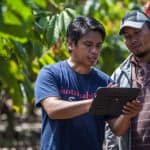Inclusion Requires Interoperability: Why All Digital Financial Services Should be Interoperable
I learned in grade school that the telephone was invented by Alexander Graham Bell in the late 19th century, but only recently did I learn that the earliest precursor to the modern telephone actually dates back to the 7th century AD. The Chimu civilization in Northern Peru invented a string telephone using gourds and stretched hide, using it to speed up communication with one another. This illustrates a fundamental characteristic of humans: We have always wanted to find new and better ways to connect and to make life more efficient. But the emergence of the modern telephone also highlighted a downside of technological development: New technologies can be a source of inequality if many people are excluded from accessing them.
Nowadays, technology permeates every aspect of modern life — and it still plays a role in both connecting us and separating us as a global society. While advances in technology bring new opportunities for efficiency and growth, if we’re not careful, these advances can leave behind those with fewer resources who cannot access these new tools, exacerbating the digital divide that still persists around the world.
Addressing Inequality in Digital Financial Services
One example where this inequality is abundantly clear is digital financial services, an area I focus on in my work at the Interledger Foundation. Historically, financial services were built in a way that strategically excluded people, profiling them based on their likely profitability to the service provider, and prioritizing services to those customers who were deemed to offer higher value. This meant that people who wished to make smaller transactions, or who had fewer assets to serve as collateral for credit, were not able to access these financial services — even though they were often the customers who needed them the most.
As of 2021, these excluded customers numbered 1.4 billion people globally, and their financial exclusion is restricting economic and individual growth around the world. Fortunately, there’s a growing awareness of this issue, and financial inclusion is considered to be a critical enabler in meeting many of the United Nations’ Sustainable Development Goals (SDGs), including ending poverty, eliminating hunger, improving health, providing quality education and supporting economic growth. As a result of concerted global efforts, the financially excluded population declined by over 1 billion from 2011 to 2021.
Progress has also been made through the emergence of digital products and services aimed at people who have traditionally been excluded. A promising example is the success of mobile money products primarily targeted at emerging markets with large unbanked populations, where financial inclusion is imperative to economic participation and growth. Within 15 years of its creation, mobile money has seen explosive growth among these unbanked and underbanked communities, and the micropayments made by these customers — who were once deemed unworthy by banks — now account for $1.4 trillion per year in transactions worldwide, contributing $600 billion to the GDP of the countries where these services operate between 2012 and 2022.
These services have enabled substantial advances in financial inclusion, connecting previously excluded communities with vital services that can improve their lives. However, they’ve also highlighted a new type of disconnection — one that’s increasingly important in today’s tech-fueled world: the lack of interoperability between digital systems.
The Need for Interoperability in Mobile Money
While some mobile money systems enable payments between different mobile networks, others remain restricted, only allowing users to transact with others who use the same network. For these services to take the next step in their evolution, we need to provide a bridge to connect different closed networks and allow them to transact with each other in ways that are safe, efficient and accessible to all. There is a way to do this: by leveraging interoperable technology. In the payments space, this technology connects previously fragmented services, particularly within emerging economies, allowing transactions between different people and networks — without being limited by particular banks, mobile money providers or even borders.
Interoperability is a win-win for both individuals and service providers — along with the broader economies in developing countries. On the individual level, mobile money consumers are better served through more seamless, connected services, increasing access to previously underserved populations. On the business and broader economic level, interoperability results in more robust financial ecosystem development, enabling greater regulatory oversight and support, with increased transparency and traceability.
Moving Towards Universal Interoperability
Moving toward universal interoperability in mobile money and other digital financial services would cause a paradigm shift in how these sectors operate. But of course, there are challenges to fostering this degree of connectivity among technology platforms. Interoperability requires standardization, regulatory frameworks and protocols, which can be more difficult to implement when dealing with legacy systems and fragmented ecosystems. Furthermore, it does not address the underlying and pressing need to expand internet connectivity and energy access in parts of the world where they are currently limited, without which interoperable platforms could not function.
But these limitations should not prevent us from designing a future in which tech infrastructure supports inclusive growth. We operate in a fast-moving technological landscape where it’s not enough to provide a service if large segments of potential users are restricted from benefiting from it. To avoid that, tech developers, global development organizations and other stakeholders must embrace the view of technology as the gateway to accessing essential financial services, ensuring that everyone is included. I believe it is possible to support emerging economies in a way that benefits everyone, and prioritizing interoperability in digital finance is essential to that process. Failing to invest in interoperability will inhibit growth and increase the already-substantial digital divide in these countries.
But though the need for interoperable technology is particularly apparent in digital financial inclusion, it’s also relevant to other areas of economic development. As we build new technology, it is essential to ensure that we do not, by design or default, create silos that propagate exclusionary practices. Every aspect of technology today has that potential to include or exclude, and I believe we have a collective responsibility to ensure everyone can access it. When we allow different technologies to work together, a culture of innovation is nurtured and new products, services and economic models can be developed to address the unique challenges faced by traditionally excluded communities. If we fail to do this, we will restrict economic development and limit access to essential infrastructure around the world.
Just as the modern telephone both connected people and created a divide between those who did and did not have access to it, so too can any new technology be used to foster or inhibit widespread access. If we want technology to live up to its transformative potential, we need to continue building bridges. Put simply, inclusion requires interoperability.
Briana Marbury is the President and CEO of the Interledger Foundation.
Photo credit: Monito – Money Transfer
- Categories
- Finance, Technology, Telecommunications



